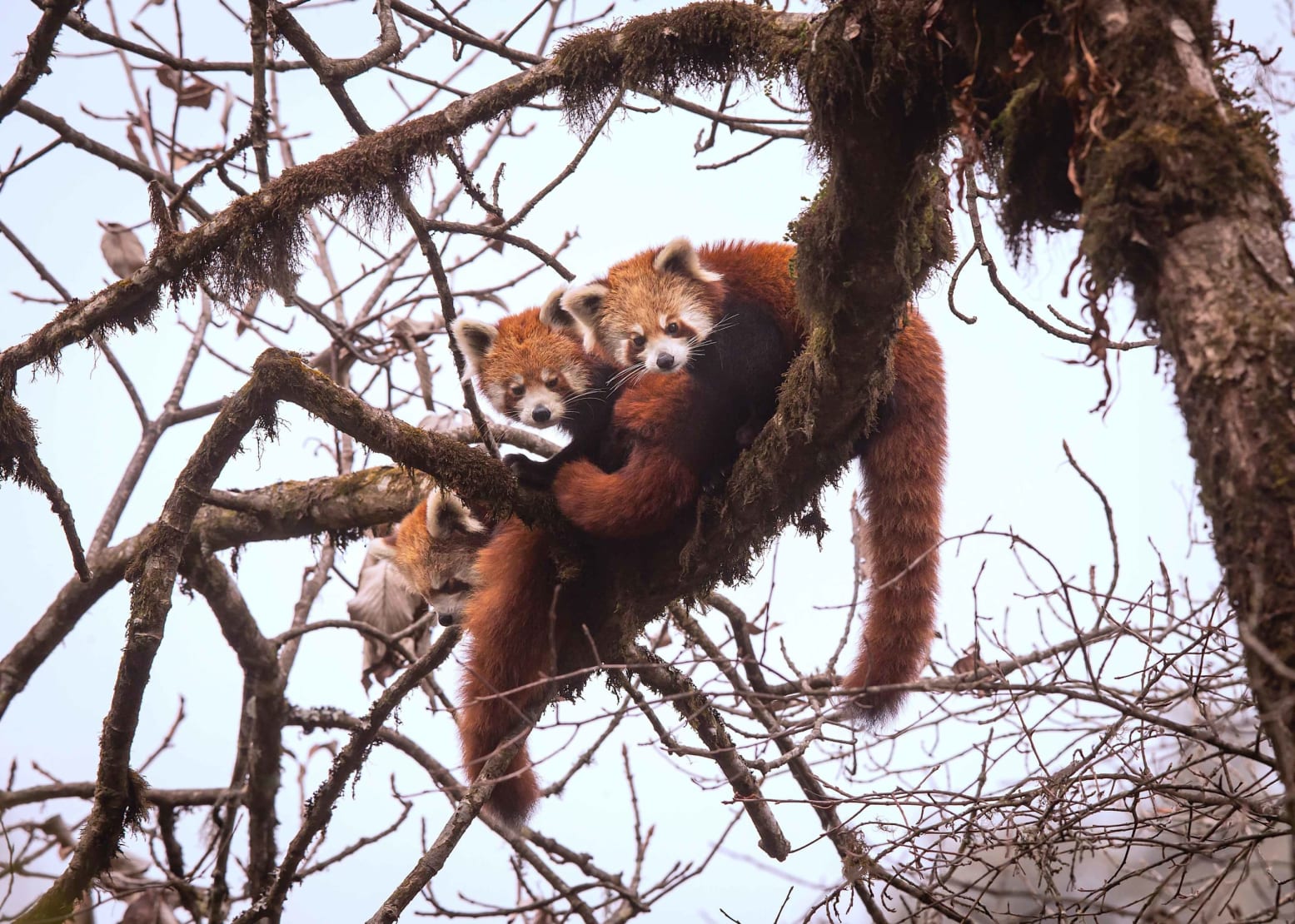 Listen to this article
•
15:34 min
Listen to this article
•
15:34 min
A pair of yellow-throated martens (Martes flavigula) sprinted up the mountainside at the sight of approaching trekkers. The backpackers yelled “panda, panda” after them as the nimble predators disappeared out of sight. Observing this drama unfold one April morning in 2021 at Singalila National Park in West Bengal, I chuckled at their confusion over the animal’s identity.
Renowned for the trek route to Sandakphu, the highest peak in West Bengal that passes through Singalila, the 78-sq-km park is one of the few natural habitats of the red panda (Ailurus fulgens) in India. Increased awareness about its presence in this Eastern Himalayan forest has led trekkers to anticipate sighting this endangered mammal. And, like that morning, they sometimes mistake the relatively easier to spot marten for the elusive panda.
Wildlife photographer Sourav Mondal who leads expeditions to spot the red panda in the landscape has had some extraordinary sightings over the years. “I have been exceptionally lucky to see red pandas courting each other, mating, and taking care of their young. Once, a mother panda looking for her lost cub came as close as five feet from me,” he says.
Though it is the hope of seeing a red panda that draws wildlife tourists to Singalila, the park also harbours other mammals: leopard (Panthera pardus), clouded leopard (Neofelis nebulosa), Asiatic black bear (Ursus thibetanus), barking deer (Muntiacus vaginalis), Himalayan serow (Capricornis sumatraensis thar), Himalayan goral (Naemorhedus goral), wild boar (Sus scrofa), Royle’s pika (Ochotona roylei), and Chinese pangolin (Manis pentadactyla). Sighting mammals in Singalila is not as easy as spotting birds. The heavy footfall of trekkers and the increasing number of vehicles passing through the park makes it difficult to catch a glimpse of these shy animals. With his camera trap photographs, wildlife photographer Shivang Mehta hopes to draw attention to some of the lesser-known mammals of this landscape.
“The sheer number of trekkers and jeeps adds pressure on wildlife. Sighting a serow or goral was quite common until around five to six years ago. We used to see them crossing roads every two or three days. That is not the case anymore,” adds Mondal.

Often referred to as the black panther, a melanistic leopard (top) is a black-colour variant of the Indian leopard (above). These leopards are black due to a genetic condition called melanism in which the animal overproduces melanin, the dark colour pigment in skin and fur. Melanistic leopards also have rosettes, but they are not easily visible under their black coat.
“Villagers reporting sightings of black panthers sparked my interest. I started my camera trapping work outside the park’s boundaries in 2017 due to the presence of this flagship species in the landscape. In searching for the black variant, we photographed quite a few rosetted ones as well,” says Mehta. Photos: Shivang Mehta
Beyond the leopards, the camera trap caught an astonishing array of mammals. These images, taken in 2021, included a leopard cat (Prionailurus bengalensis; top left), Asiatic golden cat (Catopuma temminckii; top right), Malayan porcupine (Hystrix brachyura; above right), and masked palm civet (Paguma larvata; above left) walking along trails in the lower areas of Singalila, outside the national park’s boundaries.
“It is great to see that the images we have created over time are helping to spread awareness among the local community,” Mehta says. “What everyone initially thought to be a black domestic cat turned out to be a black morph of the golden cat, one of the rarest wildcats found in India. Thanks to our documentation, the local community is now aware of the presence of these animals. I believe the community science infrastructure that we have been able to develop at a local level over a period of time will go a long way in conserving these species and their habitats. I feel if proper infrastructure is created with night safaris conducted outside the park, tourists will have a fair chance of seeing some of these nocturnal species,” he adds. Photos: Shivang Mehta

Red pandas are arboreal mammals that mate once a year, after which the female gives birth to a litter of 1-4 cubs. The cubs take around a year to reach adult size and stay with their mother (extreme right) until they are about 18 months old.
“My first sighting of the red panda was when I saw this family of three in February 2016, around the time when red panda-centred tourism began here. We spotted three of them on separate occasions in a week. It was special to observe the family dynamics of a species that I had been aspiring to document,” says Mehta. Photo: Shivang Mehta

The yellow-throated marten is commonly seen in Himalayan forests in India. These feisty predators usually feed on squirrels, birds, snakes, and lizards.
In Singalila, snowfall begins around end-November and may continue intermittently up to late April. Mondal, who photographed this individual in January 2017, says, “It was in pursuit of some laughingthrushes at Kalpokhari, which lies at an altitude of around 3,000 m within the park. Though frequently seen at this altitude, they are extremely shy. They will bolt as soon as they see humans.” Photo: Sourav Mondal
(Left) A broad, dark mask that extends from its muzzle to below the ears identifies the masked palm civet. Unlike other species of civets, it doesn’t have any stripes or spots on its body. Comfortable living in trees and on the ground, the masked palm civet mainly eats wild fruits. According to Mondal, getting a glimpse of this primarily nocturnal, solitary mammal is rare. “We were searching for red pandas around 9 am when we saw something grey moving about in the tree branches. And then suddenly, the civet popped its head out from the foliage,” says Mondal.
(Right) The Sikkim vole (Neodon sikimensis) is a small, mouse-like rodent inhabiting alpine meadows and dense vegetation growing at the edges of rhododendron and coniferous forests between 2,100 m and 3,700 m. It lives under rocks, bushes, or leaf litter and rarely ventures out into the open. Besides Sikkim, this vole is found in West Bengal. Mondal has seen it only once in March 2017, near his homestay in Tumling. He quickly took a photograph of the tiny and difficult to spot creature before it disappeared. Photos: Sourav Mondal

The hoary-bellied squirrel (Callosciurus pygerythrus) usually inhabits evergreen and semi-evergreen forests at altitudes between 500 m to 1,560 m. In India, it is found chiefly east of the Brahmaputra, but its range also extends to the foothills of the Himalayas. It feeds on flowers, fruits, bark, seeds, leaves, insects, and lichens. Mostly active in the morning, these squirrels are known to nest in tall bamboo and oak trees. They make nests of leafy twigs and branches. Photo: Dhritiman Mukherjee

The yellow-bellied weasel (Mustela kathiah) lives in Northeast India at altitudes between 1,000 m and 4,000 m. As its name suggests, it has a yellow belly, while the top of its body and tail are dark brown. It preys on birds, mice, rats, voles, and other small mammals.
“In April 2017, this yellow-bellied weasel entered my room by pure accident. It was jumping all over the place, and toppled a few glasses of tea before deciding to hide under my bed. I finally managed to open a window to let it out. I had no idea which species of weasel it was when I took this photograph,” says Mehta. Photo: Shivang Mehta












